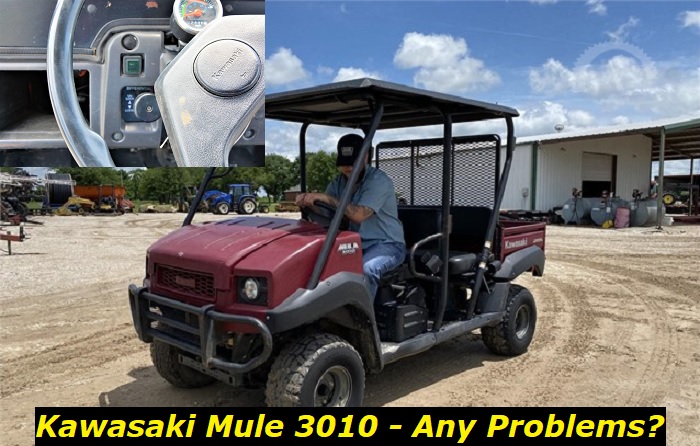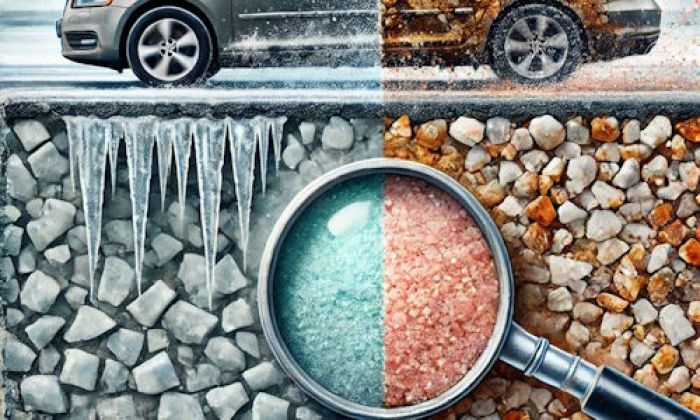Kawasaki Mule 3010 is one of the series of very heavy utility machines built by an automotive company, Kawasaki. This multi-use lightweight equipment is one of the generations of MULE whose production started in 1988. Despite the impressive operation of this worker, here are some Kawasaki Mule 3010 problems that users may experience.
Some of these problems are common while others are rare. That is why in this article, we will be discussing some of the major problems associated with using the Kawasaki Mule 3010. So, to find out what can go wrong with the model, keep reading.

An Overview of the Kawasaki Mule 3010
The Mule 3010 is the 11th generation of the Mule series since the production of the 1000 series. Design primarily for ranch work, this equipment has met with modifications that have increased its functionalities. The functions now include recreation and hunting.
When it comes to design, this mule is durable 4×4 equipment that was produced from 2001 to 2008 by Kawasaki. At first look, it looks like a golf cart but resembles a pickup truck on a closer look. When it comes to modification, it is available as a two or four-seater worker. This series features an open-cab chassis, gas and diesel trims, and importantly a 617cc twin-cylinder engine on a four-wheeled drive.
Kawasaki Mule 3010 Specifications
Engine
The engine of this vehicle has liquid cooling with a four-stroke propeller under the tilt bed with a V-twin OHV. With a compression ratio of 10.3:1 and an engine displacement of 617cc, this is a powerful tool. It also contains a fuel tank with a space of up to 24.2 liters, which is enough for most users. In the engine section, the ratio of the bore to stroke is a distance of 76 x 68 mm.
Kawasaki Mule 3010 engine is designed to match the needs of workers in the mining industry and agriculture. Although it has been drafted into tourism by a few, its major purpose remains exploited by ranch owners. The engine is ergonomically designed with aesthetics that support the tough duty it carries out.
Lubrication
Reducing friction is a very important aspect of every machinery and this product is not left out. The worker. It is equipped with a forced lubrication (wet-sump) system having an oil capacity of close to 2 US quarts. The applied oil must have a minimum API grading of SJ and one of the most recommended oils in this group is an SAE 10W-40. In addition to this, the oil should contain no additives or modifiers.
The front gear oil capacity is 0.4liters of API grade level 5 or 6 Hypoid gear oil with a fluidity of SAE 90 and other viscous gear oils with higher anti-friction qualities. The transmission oil capacity on this vehicle is 2.5liters usually of gear oil with extreme pressure.
Drivetrain
The Mule 3010 has a dual-mode rear differential and a 5.4 (81/15) reduction ratio two-speed shaft-driven final drive. On the dash is a switch that lets you choose between 2WD and 4WD drivelines. To the left of the steering shaft, there is also a shift lever for locking and unlocking the rear differential.
Tires
In a vehicle, it is normal for the rear wheels to have a higher pressure, this vehicle has a recommended rear pressure of 168 kPa. The front wheel, which is always smaller has a recommended pressure of 70 kPa. A little above 240 kPa, at an equivalent of 36 psi is the maximum pressure recommended for seating tire beads.
For proper friction reduction and ample grip of the wheel, steel rims are recommended. Also, the front and rear wheels use tubeless tires like the Dunlop KT869 23 × 11-10.
Brakes
The Mule 3010 brake system consists of a dual piston in a drum brake formation with a front hydraulic arrangement. For the brake system of this worker to be operable, it must be maintained at a free-play within the 2-10 mm range. The use of only DOT3 brake oil is also important.
The brake-pedal ratio and the master cylinder work together to give this vehicle its stopping power. In addition, a mechanical parking brake is found on the driver's side by the left.
Suspension
The front suspension of this vehicle comprises struts from MacPherson having wheel travel of 3.89 inches (100mm). A semi-dependent axle is employed by the rear suspension with 2.79 inches (70mm) travel.
With a toe-in of 0-20 mm, this suspension system is joined with a 46-inch wheelbase and rack-and-pinion steering. This system provides over a 145-inches radius of turn, plenty of traction, and ample bump absorption.
Dimensions
The Mule 3010 overall dimension varies from the other models and is estimated to be 124.76 × 57.05 × 76.10 mm. Distance from the ground is about 6.97 inches; the height of the seat is about 34 inches for front seats and 35 inches for rear seats. Also, there is a distance of about 45 and 47 inches for the wheelbase.
Furthermore, the weight of the vehicle on a full tank of fuel is 700 kg while its fuel-less weight is 670 kg. The cargo bed dimensions of this vehicle are 30.30 × 47.68 × 11.35 inches or 50.40 × 47.68 × 11.28 inches.
Capacities
Including the occupants, accessories, and cargo, the capacity limit of the Kawasaki Mule 3010 is 600 kg. The luggage space capacity for series with long beds is 360kg and 184 kg for those with short beds. Also, the towing capacity is 544 kg.
There is under-hood storage in the front of the Mule even though it is unspecified in the instruction manual. Plus the cargo, this vehicle can contain two occupants, while the 4 × 4 can seat up to four.
Exterior
With many available body materials, the model can be green, red, or classic camouflage. In addition, maintenance is easy with its tubular, steel ladder-type frame. It is protected against dirt and elements.
The design of the vehicle gives it a circular front, a square rear, and an angular nose. Most models feature ROPS-matching black bodywork and the hood of the vehicle is designed in single or multiple-toned colors.
Price
The Mule 3010 was in production for nine years from 2001 to 2008. Prices of these models vary between the list prices and the retail prices. For example, the list price for one of the 2001 models (KAF620E1) is $8,799 while the retail currently is $1,600.
Most of the series of the 4 × 4 four-seater Mule 3010 have a list price between $8700 and $10,900. While their retail price is from $1,600 to $3,885 with trade-in prices ranged $3250 to $5,905. Hence, the price of the vehicle varies depending on the year model, and the condition of purchase.
Major problems associated with the Kawasaki Mule 3010
A lot of things can go wrong with this worker but here are three problems to look out for.
Drivetrain Noise
Since this product is over 14 years now, it is one of the old mules and has spent its time, one of the expectations I that it produces abnormal engine noises. This noise is a pointer to a defective engine, suspension, transmission, or drive pully components. While it is not normal, some of the causes of this problem include:
- A dented transmission gears
- Malfunctioning LSD clutch friction
- Loose or old drive pully sheaves
- A faulty or chipped universal joint
Whatever the problem you may think of, it is necessary to check the state of the sheaves, belt, and V-belt assembly. Swapping out worn-out or faulty parts and replacing the necessary components could be an easy fix. In case of persistence, visiting the dealer or local mechanic is recommended.
Overheating
Overheating is a problem for many old vehicles as they can no longer handle tenacious duties like before. In a Kawasaki Mule 3010, several mishaps may be responsible for this problem. An incorrect air-fuel mixture causes heated combustion, high compression, inadequate lubrication, cooling system issue, and converter engagement.
When not immediately handled, overheating can lead to increase fuel usage, limited acceleration, an engine problem, and a reduction in vehicle performance. If you experience any issue with rectifying the problem stated above, then check online tutorials or visit a local mechanic.
Starting Issues
The problem with starting a vehicle is one of the most common issues experienced with any motor. When a Mule 3010 shows this problem, it usually indicates clogged fuel lines. This will be shown by the reduction in performance, non-rotating starter, and restricted fuel flow.
Before moving for a carburetor change, you should ensure that the electrical system, air intake, and ignition are intact. Also, checking the Mule 3010 parts for necessary replacement and repair is important.
Whatever the problem you identify, you should confirm if it's the only issue or if there are other associated damages. For example, in electrical damages, ensure that the relays are working, the ring gear is not faulty, and the spark plug is operational.
Conclusion
Although there are many Kawasaki Mule 3010 problems, three of the major problems are highlighted in the section above. Like every other vehicle, few things can go wrong with this worker.
These problems include drivetrain noises, overheating, starting problems, and many others. Nevertheless, it is important to isolate the cause of the problem either through the symptoms or troubleshooting to minimize damage.
About the authors
The CarAraC research team is composed of seasoned auto mechanics and automotive industry professionals, including individuals with advanced degrees and certifications in their field. Our team members boast prestigious credentials, reflecting their extensive knowledge and skills. These qualifications include: IMI: Institute of the Motor Industry, ASE-Certified Master Automobile Technicians; Coventry University, Graduate of MA in Automotive Journalism; Politecnico di Torino, Italy, MS Automotive Engineering; Ss. Cyril and Methodius University in Skopje, Mechanical University in Skopje; TOC Automotive College; DHA Suffa University, Department of Mechanical Engineering






Add comment